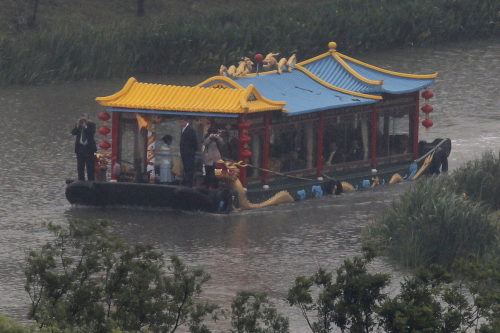BEIJING (AP) ― Reclusive North Korean leader Kim Jong-il’s visit to crucial ally China highlights his regime’s increasing dependence on its giant neighbor amid his country’s economic collapse and diplomatic isolation over its nuclear program.
This is Kim’s third trip to China in just over a year, indicating an interest in the market economy initiatives that Beijing is believed to be pushing for in North Korea. But previous reform attempts have been abandoned in spite of chronic food shortages, and it’s far from clear how far the ailing 69-year-old Kim ― or his anointed successor, son Kim Jong Un ― would be willing to go.
 |
A boat carrying security guards floats near a park in Yangzhou on the fourth day of North Korean leader Kim Jong-il’s secretive trip to China. The boat was among several that were dispatched around the area during the reclusive dictator’s visit. (Yonhap News) |
“For North Korea, it won’t be easy to reform its economy and open up itself to the outside world,” said Kim Yong-hyun, a professor of North Korean studies at Seoul’s Dongguk University.
Kim arrived in the eastern Chinese city of Yangzhou late Sunday after crossing the border Friday in his special train, South Korea’s Yonhap news agency and YTN television reported.
Both cited unidentified sources in the city west of Shanghai as saying Kim visited sites related to the solar power industry in the city on Monday morning. Yonhap said he had been greeted at Yangzhou’s train station by Vice President Xi Jinping, who is expected to be China’s next leader, and was thought to be planning to hold talks with Xi and former President Jiang Zemin, a native of the city.
Kim’s visit was surprisingly confirmed Sunday by Chinese Premier Wen Jiabao at a summit in Japan, in an indication of China’s desire to push the reclusive communist country to remold its moribund economy.
By agreement, Beijing and Pyongyang usually announce Kim’s visits only after he has crossed back into North Korea, but Wen was quoted in a statement as telling South Korean President Lee Myung-bak that Beijing invited Kim to give the North Koreans “a chance to understand the Chinese development and use it for their own development.”
China is keen to see economic reforms in North Korea because it wants to avoid a churning mass of instability on its border as a result of an explosive mix of poverty and repression.
North Korea’s exchanges with China have grown even more important since ties with South Korea soured after a new government took office in 2008 and the U.N. and others enacted sanctions to punish the country for violating nuclear agreements.
South Korea’s conservative government halted unconditional food and fertilizer shipments in early 2008 and has suspended almost all trade, costing the North tens of millions of dollars in lost income.
Its status as an international pariah deepened after last year’s sinking of a South Korean navy ship and the shelling of an island community by North Korea.
“What North Korea is trying to do now is to get rid of international isolation as soon as possible,” said Fang Xiuyu, an analyst at the Center for Korean Studies at Fudan University in Shanghai.
Not only is China, the North’s main diplomatic protector but also the chief supplier of food and fuel of the country dealing with cyclical food shortages. The United Nations says 6 million people ― a quarter of North Korea’s population ― need emergency food assistance.
Kim’s trip comes ahead of planned new economic development projects along the Chinese border.
The idea is to facilitate Chinese trade and investment with North Korea through the paving of a road between the Chinese city of Hunchun and the North Korean port of Rajin, South Korea’s Chosun Ilbo newspaper reported.
A Chinese shipping line also sails regularly from Rajin to the South Korean port of Busan, where cargo is easily moved onward to Japan.
Another project would see China develop North Korea’s Hwanggumpyong island along their border, the paper reported.
The projects would allow North Korea to profit as a broker for Chinese exports, but don’t signify any further liberalization of the North’s centrally planned economy, said Ian Davies, an Australian consultant who worked on a U.N. project to develop the area during the 1990s.
Rajin is a relatively dynamic economic zone and offers China an alternative export conduit to South Korea and Japan to help relieve logjams at its main northeastern port of Dalian, Davies said.








![[Today’s K-pop] Blackpink’s Jennie, Lisa invited to Coachella as solo acts](http://res.heraldm.com/phpwas/restmb_idxmake.php?idx=644&simg=/content/image/2024/11/21/20241121050099_0.jpg)